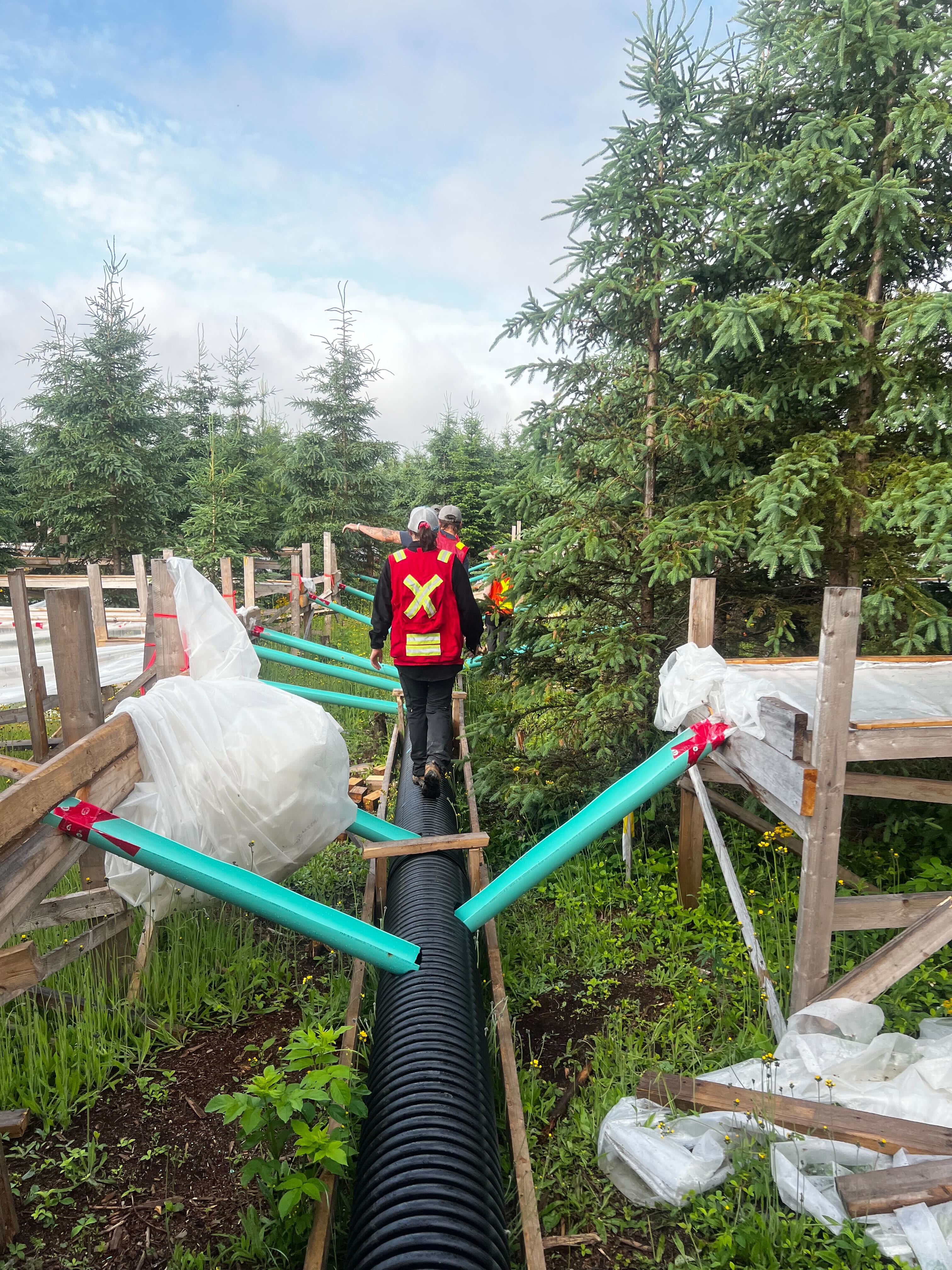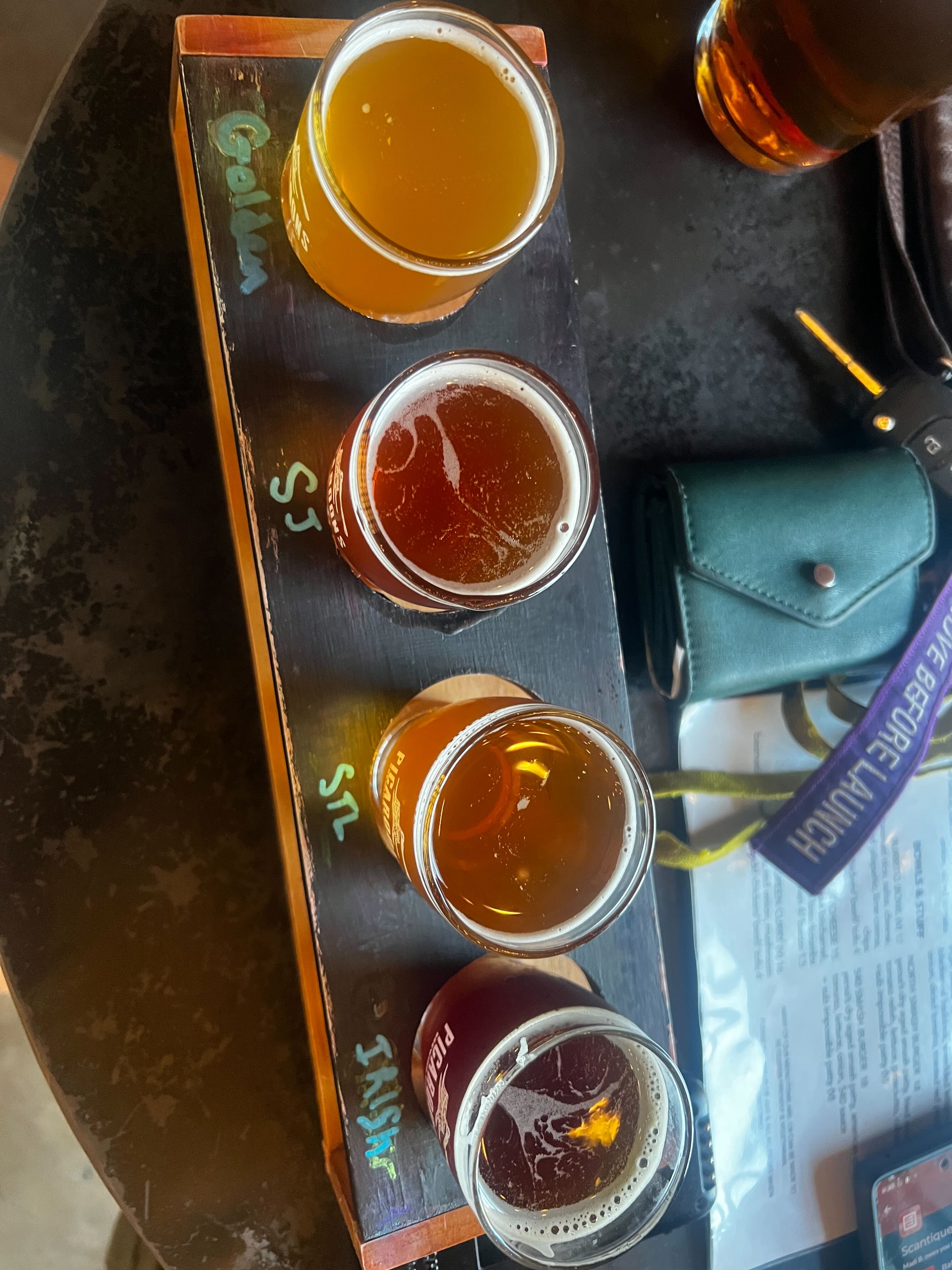Droughting experiments in New Brunswick
Blackbrook Research Forest Drought and Thinning
</div>

As a remote-sensing data-scientists most of my data is observed from the earth surface. As an observer, I do not directly manipulate my study sites. Thus, it was exciting to go out to an experiment that built and implemented treatments to test the relationship between independent and dependent variables. An independent variable is a variable that is manipulated to test if the dependent variable will change as a response. In the drought experiment we visited, which is the MSc Chloe Larstone Hunt at University of New Brunswick, there are two independent variables (1) level of thinning between trees and (2) level of drought. Each of these independent variables have strata or levels: (1a) high thinning and (1000 stems per hectare) (1b) intermediate thinning (1500 stems per hectare) and (1c) low thinning (2000-3000 stems per hectare). The second independent variable is drought level. These are: (2a) no drought (2b) 25% drought and (2c) 50% drought. This gives a total of nine combinations. In science, you need replication so there are 18 plots (2 replications) in this exciting drought experiment.
I have always been interested in this project because it is a tree-sized version of the famous and wide-spread drought network (DroughtNet) which is a global network of experiments with standard protocols that allow us to better stand the impact of drought in many different environments. You can learn more at their webset( DroughtNet ). While this Silva21 is not part of DroughtNet - it is one of the first experiments to use a similiar structure to look at things larger than low-lying vegetation - trees!
We got to the site early because we had a long drive to Quebec. The site is located deep in JD Irving’s private landbase. Along the 40 minute drive we passed two different JD Irving sawmills. The scale of Irving’s forest operation is something to behold, and something that can be hard to understand if you are not there to experience it yourself.
The site itself is small, and I knew it would take less than 30 minutes to fly. I was optimistic about satellite connection because it was flat and open - a dream for accurate GPS. We took the opportunity to explore the different experimental strata. We clambered over a massive network of PVC pipes and timber to explore the nine types plots. In plots that are droughted, a plastic tarp lies at diameter at breast height or DBH and directs water away from the ground (where the tree roots are) to a PVC pipe network that deposits the water downslope from the site itself. In the 25% drought, 25% of the plot area is covered plastic tarping, and the same but greater in the 50% plots. In half the sites, some of the trees have been removed - theoretically water stress from competition.

Chloe and her lab mate Katie Tripp (the first Tripp I am not related to I have ever met!) are measuring the seasonal growth metrics and confirming the soil water differences among plots. They measure seasonal growth using dendrometer bands which monitor the change in DBH for the trees. Trees will constrict (minorly) when water stressed - so it is great way to see how trees may adjust to droughting.
Undroughting Experiments in New Brunswick
I have just spent the first part of this blog post discussing an droughting experiment, but now I want to switch gears to discuss an important “undroughting” experiment we have been conducting throughout New Brunswick. You can see a sample of the trial below:

You guessed it - the craft beer scene. While New Brunswick may not be known for its breweries, we three Vancouverites (which is known for its craft breweries), want to change that. The beers I had in New Brunswick are some of the best beers I have had in in North America. Here is a ranking of the beers from each field member (don’t worry we shared!)
Sarah’s Top Beers
- Epoutnique Hazy IPA - Brasseurs Du Petit-Sault
- remarks - “This beer is the best hazy IPA I have ever had, the perfect combination of not too citrusy and not too sour. It just works.”
- Simeon Jones Amber Ale - Picaroons Brewing
- “Craft” - Novum Boreas
- Serie Epic Strawberry Rhubarb Sessional Lager - Brasseurs Du Petit-Sault
- Strawberry Lime Margarita Sour - York County Cider
- 506 Golden Ale - Picaroons Brewing
- Swallowtail Light - Picaroons Brewing
- Irish Red -Picaroons Brewing
Madi’s Top Beers
- Epoutnique Hazy IPA - Brasseurs Du Petit-Sault
- remarks - “Wow what a refreshing summer beer!”
- Souer Catherine
- “Craft” - Nuvum Boreas
- Melon Head - Picaroons
- Snap Dickie - Brasseurs Du Petit-Sault
Evan (Bud’s) Top Beers
- Pop Rouge - Brasseurs Du Petit-Sault
- Epoutnique Hazy IPA - Brasseurs Du Petit-Sault
- Souer Catherine Old School IPA - Brasseurs Du Petit-Sault
- Melon Head - Picaroons
- Summer Sour Ale - Brasseurs Du Petit-Sault
- Strawberry Lime Margarita Cide - York County Cider
So where are we know? Deep in Northern Ontario - stay tuned for a post on how I, an international student became a Remotely Piloted Aircraft (RPA) pilot in Canada!
Key Science Terms
- Independent Variable: The variable that is changed to understand an impact or effect. In typical experiments (like the Blackbrook drought study) this is the variable that is changed by the researcher (thinning and drought).
- Dependent Variable: The variable that is measured to test the response. This is not changed by the researcher but is measured (the dendrometer measurements)
- Strata : Levels of an experiment treatment. In the blackbook site this goes from no drought, 25 % drought and 50 % drought (three strata)
- replication : Sets or repeats in an experiment that have the same independent variable manipulations. There are two of the same plot types in the Blackbrook research experiment.
- Diameter at Breast Height (DBH) : A famous measure for tree scientists. This is a critical metric for modeling tree volume, growth, and stand development. It’s so important that if you ask any forest scientist what height on their body is DBH they can immediately tell you because they need to know every time they walk up to a tree.
- Dendrometer Bands: Metal bands installed on trees (generally at DBH) that give precise growth measurments. Measures made before and after the growing season show annual growth rates. Blackbrook also has electronic dendrometer bands installed that measure changes every 15 seconds. This gives a constant measure of the trees. Droughts generally decrease the daily changes in tree diameters, so we can better see strees.